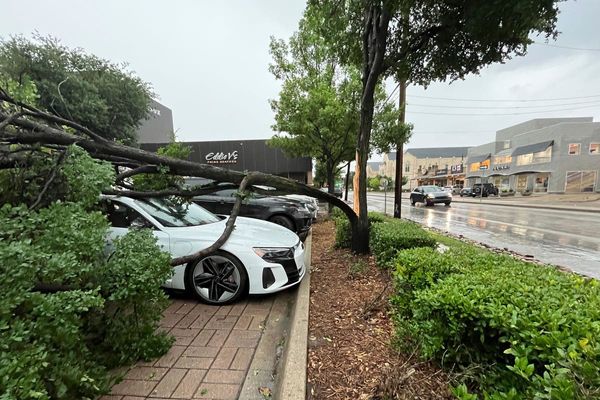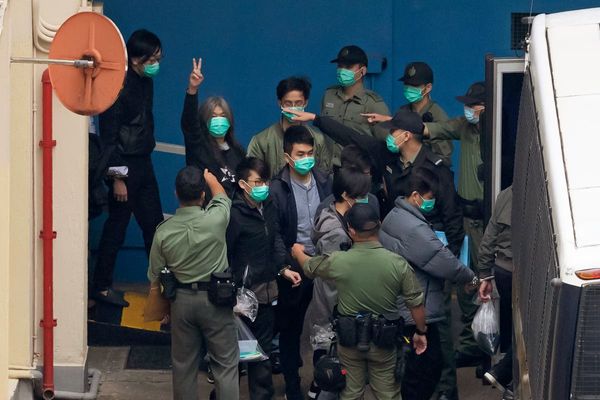
For decades, Ken Brock and Gary Enos largely toiled in the same hangars at New Hampshire’s Pease national air base. The career US national guard members were responsible for giving fuel planes tail-to-nose inspections that prevented crashes.
“We were like general practitioners for planes,” Enos said.
Like hundreds of others who served at Pease, both developed cancer, which they and their families believe was probably from exposure to staggering levels of toxic PFAS “forever chemicals” in the base’s drinking water.
Brock died in 2017, and Enos has survived two bouts of cancer. Yet despite the similar career paths and illness, the military paid for Enos’s care and disability benefits – but not for Brock and his surviving wife.
Since then, the military has been fighting efforts by Brock’s widow, Doris Brock, to get benefits for her and service members who worked for decades at the base. It denies PFAS is behind Pease’s high cancer rates, and helped kill legislation to fund a cancer study that could have proved it wrong.
Doris Brock is now leading the charge in a two-pronged David-versus-Goliath battle: she and a group of veterans’ advocates aim to prove Pease’s toxic water is behind the base’s cancer levels, and, on her own, she is pushing to change federal law so career national guard members who do not have sufficient active duty time can still get veterans’ benefits.
Though her husband died in 2017, Brock says she is “still angry”.
“He has been gone for five and a half years, but it’s gone from a personal nature to a ‘This isn’t right for everyone else still out there,’” she added. “So many people who worked on this base are hurting.”
Pease is home to the 157th Air Refueling Wing, and the base also holds 13 superfund sites, which is a designation for the nation’s most contaminated land. Among the pollutants are PFAS, a class of chemicals typically used to make thousands of consumer products resist water, stains and heat. They are linked to serious health issues such as cancer, kidney disease, fetal complications, liver disease and autoimmune disorders.
For decades beginning in the 1970s, Pease’s service members drank contaminated water. The Environmental Protection Agency last year issued new advisory health guidelines that found virtually no level of exposure to two different kinds of PFAS is safe – Pease’s levels were tens of thousands of times above those thresholds.
The situation is nearly identical to that at Camp LeJeune in North Carolina, where the military has agreed to pay benefits for those who served at the base and drank contaminated water. But at Pease, the military is using what veterans advocates say are unfair rules or seemingly arbitrary application of rules to deny care and disability payments for many of them.
When denying Brock’s benefits, the military has said it cannot be proven that Brock’s and others’ cancers stem from PFAS exposure, Doris Brock said. And though Ken Brock worked full-time for 35 years and deployed around the world to serve during combat, the military initially claimed he did not have the 90 days of consecutive active duty time required for benefits.
The New Hampshire air national guard did not answer specific questions about the situation. But Brig Gen John Pogorek noted the national guard was working on the issue as part of the Pease health working group, which was established to find answers about the cancers after pressure from Doris Brock.
‘That’s when I got mad’
Ken Brock retired from Pease in 2005 and in 2015 tests revealed a bladder cancer that had nearly advanced to stage four, and doctors gave him up to five years to live.
In 2016, Brock applied for Veterans Affairs benefits that would have paid for his care, given him access to VA hospitals, and qualified him for disability payments, and Doris Brock for survivor payments after he died.
But Brock was rejected, and after trying experimental chemotherapy treatments, he died in June 2017 aged 67.
Enos had a different experience: he developed bladder cancer in 2007 and received health care and disability payments. When the cancer returned in his prostate in 2017, he used private insurance, but still continued to receive disability payments.
Though he and Brock proved they had adequate active duty time, only Brock was denied benefits. And still others who served for decades next to them aren’t receiving benefits because they do not have adequate active duty time. The situation is “not right”, said Enos, who is part of the working group.
“I want my friends and comrades to live, to get the services they need to live and to be compensated for what they have done for their country,” he added.
Doris Brock said she was told by Veterans Affairs in 2016 “it costs too much” to pay for all veterans to receive benefits.
“They said, ‘That’s why we have these rules,’” she added. “That’s when I got mad enough to say, ‘OK, fine, I’m going to fight to change the rules.’”
She set out on a “research quest” in 2016 to learn more about the link between Ken Brock’s cancer and Pease’s contamination and quickly found dozens of service members around his age also had cancer, and learned about the high PFAS levels in the drinking water.
‘There’s a problem’
After Brock pulled together a coalition of veterans and advocates in 2018, the group seemed to score a major victory when the military agreed to do a cancer mortality study, which Congress funded in that year’s defense bill.
But the military probably only agreed to it because they know mortality studies are of limited use, said Mindi Messmer, a scientific adviser for the Pease health working group. It only looked at death rates, and fewer people are dying from cancer because of advancements in medicine and early detection.
“If a bunch of people are getting sick from their service but not dying then there’s less of a case for the military to have to pay benefits,” Messmer said.
Still, the death rates at Pease are so high that the 2021 results revealed statistically elevated levels of prostate, breast and lung cancers.
“Sometimes, as much as they try not to show it, they can’t bend things that much and they have to admit there’s a problem,” Messmer said.
A mortality study also does not prove the water at the base is behind the elevated cancer levels. Proof requires a cancer incidence study. Funding for an incidence study was included in the version of last year’s defense bill that passed the House, but it was stripped from the final Senate bill.
Advocates said they were told by their congressional delegation that the military did not want the study, so it was left out.
“I can’t even begin to tell you how angry I was when I heard that it was cut,” Brock said.
Gen Pogorek said the New Hampshire air guard supports a cancer incidence study and “can’t speak for why it was dropped”.
Hope also came and went when Congress passed in August the Honoring our Pact Act, which significantly expanded benefits for veterans exposed to toxins, but still excluded most at Pease.
The group is now exploring how to chart a new path forward. Separately, Doris Brock continues pushing for a bill to scrap the active duty requirements for career national guard members, and the issue is now being studied.
Though both prongs of her David-and-Goliath battle face uncertain futures after years of twisting the military’s arm, Brock remains steadfast.
“I’m not going away,” she said.







